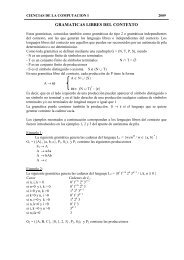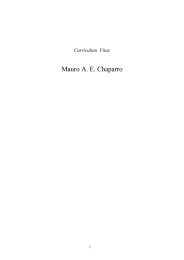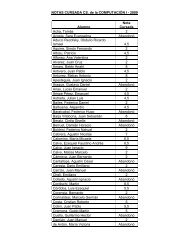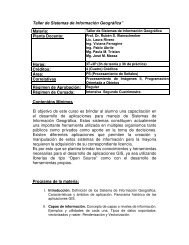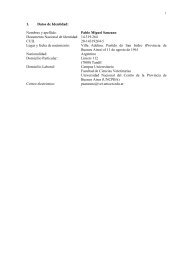Libro de Resúmenes / Book of Abstracts (Español/English)
Libro de Resúmenes / Book of Abstracts (Español/English)
Libro de Resúmenes / Book of Abstracts (Español/English)
Create successful ePaper yourself
Turn your PDF publications into a flip-book with our unique Google optimized e-Paper software.
Resumenes 74<br />
structure and functin <strong>of</strong> ecosystems. In or<strong>de</strong>r to evaluate the effect <strong>of</strong> the<br />
UVR on marine planktonic systems a mesocosmos experiment was carried<br />
out. Ten mesocosmos having 1500 liters each were incubated with <strong>of</strong> micro<br />
and mezoplancton and exposed to normal and enhanced UVR doses. The<br />
system can imagine like constituted by five biological compartments:<br />
"small" phytoplankton (cells with diameter lesser than 5 µm), "big"<br />
phytoplankton (cells between 5 and 20 µm <strong>of</strong> diameter), bacteria, predatory<br />
zooplankton (ciliates) and <strong>de</strong>tritivore zooplankton (heterotrophic<br />
flagellates). Compartments may be conected directly (by predator- prey<br />
relationships) or indirectly (via dissolved organic carbon that are consumed<br />
mainly by bacteria or via particulate organic carbon that is consumed by<br />
heterotrophic flagellates).<br />
A mo<strong>de</strong>l is proposed consi<strong>de</strong>ring logistic grow for phytoplankton<br />
blocks and exponential grow for the rest <strong>of</strong> the components.<br />
The mo<strong>de</strong>l successfully predicts fluctuations observed in the<br />
experiment. Although bacteria and phytoplankton suffer damage by UVR,<br />
their populations grow. This happens by effect <strong>of</strong> a diminution <strong>of</strong> the<br />
predator’s activity because ciliates are also damaged by UVR. An effect <strong>of</strong><br />
apparent competition between bacteria and small phytoplankton takes place<br />
since an increase in anyone <strong>of</strong> those two populations increases the number<br />
<strong>of</strong> predators producing a <strong>de</strong>pression in the other although they do not<br />
compete directly by resources.-<br />
Referencias<br />
• Booth C, Morrow J, Cochill T, Cullen J, Fre<strong>de</strong>rick H, Hä<strong>de</strong>r D (1997) Impacts<br />
<strong>of</strong> solar UVR on aquatic microorganisms. Photochem Photobiol 65:252-269.<br />
• Obernosterer I, Sempéré R, Herndl GJ (2001) Ultraviolet radiation induces<br />
reversal <strong>of</strong> bioavailability <strong>of</strong> DOM to marine bacterioplankton. Mar Ecol Prog<br />
Ser 24:61-68.<br />
• Schloss, I. y Ferreyra, G. A. 2002. Primary production, light and vertical<br />
mixing in Potter Cove, a shallow coastal Antarctic environment. Polar Biology<br />
25:41-48.<br />
• Smith, R., B. Prézelin, K. Baker, R. Bidigare, N. Boucher, T. Coley,D.<br />
Karentz, S. MacIntyre, H. Matlick, D. Menzies, M. Ondrusek, Z. Wan, K.<br />
Waters (1992) Ozone <strong>de</strong>pletion: ultraviolet radiation and phytoplankton<br />
biology in Antartic waters. Science. 255, 952-958.<br />
• Sommaruga, R., A. Oberleiter, R. Psenner (1996) Effect <strong>of</strong> UV radiation on<br />
the bacterivory <strong>of</strong> a heterotrophic flagellate. App Environ Microciol. 62,<br />
4395-4400<br />
• Vincent WF, Roy S (1993) Solar ultraviolet-B and aquatic primary<br />
production: damage, protection, and recovery. Environ Revol 1:1-12.



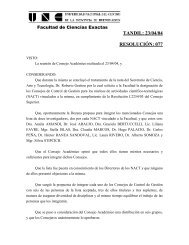
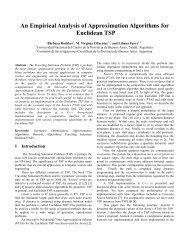
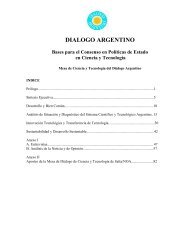

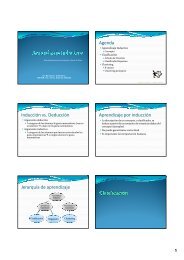
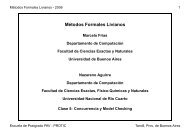
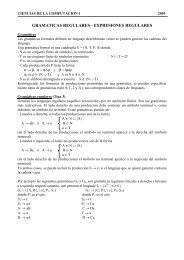
![Clase 13 [pdf]](https://img.yumpu.com/19616969/1/190x245/clase-13-pdf.jpg?quality=85)


